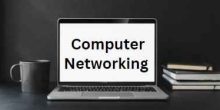UNIT 2: Physical Layer
Physical Layer: Transmission media, Signal transmission and encoding, Network performance and transmission impairments, Switching techniques and multiplexing, Overview of PSTN, ISDN, and ATM
Q121 – ATM multiplexes cells using ……………..
asynchronous FDM
synchronous FDM
asynchronous TDM
synchronous TDM
Ans – (3)
Explanation –
ATM (Asynchronous Transfer Mode) uses asynchronous TDM to multiplex cells. In ATM, data is divided into fixed-size cells, and these cells are multiplexed over the network without relying on a fixed time slot structure. The term “asynchronous” indicates that the cells are sent without a synchronized clock, making it flexible and efficient for various types of data traffic.
Q122 – The term which is used to increase the speed of the switches to handle the data is known as
Switching Routes
Switching fabric
Switching Data
Switching Frames
Ans – (2)
Explanation –
The term used to increase the speed of the switches to handle the data is known as Switching fabric.
Switching Fabric – This refers to the internal architecture of a switch that connects its various input and output ports. A high-speed switching fabric allows for efficient and rapid handling of data packets between different ports, enhancing the overall performance and speed of the switch.
Q123 – Application Adaptation Layer (AAL) can accept continuous bit streams and break them into chunks to be encapsulated into a cell at the
ATM Layer
Linear Layer
Data Layer
Transport Layer
Ans – (1)
Explanation –
Application Adaptation Layer (AAL) can accept continuous bit streams and break them into chunks to be encapsulated into a cell at the ATM Layer.
ATM Layer – The Application Adaptation Layer (AAL) is part of the ATM (Asynchronous Transfer Mode) protocol stack. It is responsible for adapting data streams from various applications to the format required by the ATM layer. Specifically, AAL segments continuous bit streams into chunks that can be encapsulated into fixed-size ATM cells for transmission over the network.
Q124 – Asynchronous Transfer Mode (ATM) technology was originally designed as a
LAN Technology
WAN Technology
DSL Technology
IP Technology
Ans – (2)
Explanation –
Asynchronous Transfer Mode (ATM) technology was originally designed as a WAN Technology.
WAN Technology: ATM was initially designed for wide area network (WAN) environments. It was created to provide high-speed, reliable, and efficient data transfer over long distances and across different types of networks. Its ability to handle various types of data traffic (voice, video, and data) made it suitable for WANs.
Q125 – The first 4-bit field of header in Segmentation and Reassembly sub layer defines a sequence number to order the bits, is called
Serial number
Channel identifier
Length indicator
Sequence number
Ans – (4)
Explanation –
The first 4-bit field of the header in the Segmentation and Reassembly (SAR) sublayer that defines a sequence number to order the bits is called Sequence number
In the Segmentation and Reassembly (SAR) sublayer of the ATM protocol, the sequence number field is used to order the segments of a data stream correctly. This field helps in reassembling the data in the correct order at the receiving end.
Q126 – In Asynchronous Transfer Mode (ATM), the network to network interfaces are used to connect the
Cells
Frames
Endpoints
Switches
Ans – (4)
Explanation –
In Asynchronous Transfer Mode (ATM), the network-to-network interfaces are used to connect the Switches.
Network-to-network interfaces (NNI) in ATM are used to connect ATM switches within different networks. These interfaces facilitate communication and routing of ATM cells between switches across the network.
Q127 – A field in CS of the AAL 5 that is used for error control for the entire data unit is
Length-error field
CRC field
User-to-user field
Common part identifier field
Ans – (2)
Explanation –
A field in the Common Part of the AAL 5 (ATM Adaptation Layer 5) that is used for error control for the entire data unit is the CRC field.
The Cyclic Redundancy Check (CRC) field is used for error detection and control in AAL 5. It ensures that the data has not been corrupted during transmission by allowing the detection of errors in the entire data unit.
Q128 – Some organizations were using X.25 (a virtual-circuit switching network) performed switching at the
Network Layer
Linear Layer
SONET Layer
UPSR Layer
Ans – (1)
Explanation –
In X.25, which is a virtual-circuit switching network, the switching is performed at the Network Layer.
X.25 performs switching at the network layer (Layer 3 of the OSI model). It uses virtual circuits for data communication and handles routing and switching of packets through the network.
Q129 – A virtual-circuit switching network X.25 was designed in the
1970s
1980s
1990s
2000
Ans – (1)
Explanation –
X.25 was developed in the 1970s by the International Telecommunication Union (ITU) as a standard for packet-switched networks. It was one of the earliest standards for providing reliable data communication over networks.
The “father” of X.25 is often considered to be Jean-Marc L. D. L. Bouffard, who was a key figure in the development of the X.25 standard.
Q130 – ATM technology supports different types of connections between two
Stations
Switches
End Users
Packages
Ans – (3)
Explanation –
ATM technology supports various types of connections, such as permanent virtual circuits (PVCs) and switched virtual circuits (SVCs), that connect end users for different types of communications, including voice, video, and data.
Q131 – To route data from one endpoint to another, the virtual connections need to be identified in
Virtual Current Nodes
Virtual Circuit Network
Virtual Cell Network
Virtual Coordinated Nodes
Ans – (2)
Explanation –
In ATM (Asynchronous Transfer Mode), virtual circuits (both PVCs and SVCs) are used to route data. These virtual circuits need to be identified and managed within the network to ensure that data is correctly routed from one endpoint to another.
Q132 – In the Legacy ATM LANs, when two stations on two different LANs need to exchange data, they can go through a converting device that changes the
Cell format
Switch format
Frame format
Segment format
Ans – (3)
Explanation –
In Legacy ATM LANs, when two stations on two different LANs need to exchange data, they can go through a converting device that changes the Frame format.
Legacy ATM LANs often involve converting data from traditional LAN frame formats to ATM cell formats. This conversion is necessary for data to be transmitted over the ATM network, which uses fixed-size cells rather than variable-size frames.
Q133 – In the pure ATM LANs, stations can exchange data at one of two standard rates of ATM technology i.e. 155 and
652 Mbps
750 Mbps
850 Mbps
900 Mbps
Ans – (1)
Explanation –
The correct higher data exchange rate for ATM technology in LANs is 652 Mbps
This means that in a pure ATM LAN, data can be transferred at either 155 Mbps or 652 Mbps, allowing flexibility and efficiency depending on the network’s needs. These speeds help ensure that data is transmitted quickly and reliably, which is crucial for applications that require high bandwidth and low latency.
Q134 – Frame Relay was designed in the late
1970s
1980s
1990s
2000
Ans – (2)
Explanation –
Frame Relay technology was developed in the late 1980s as a simplified, high-speed data communication protocol for WANs, providing efficient and cost-effective connectivity.
The “father” of Frame Relay is often attributed to Dr. John McQuillan. He is known for his significant contributions to the development of Frame Relay technology and the protocols associated with it.
Q135 – A virtual circuit is identified by a number called a data link connection identifier (DLCI) in
Transport Layer
ATM
Protocol
Frame Relay
Ans – (4)
Explanation –
In Frame Relay, DLCI is used to identify virtual circuits and manage data paths between devices.
Q136 – In the pure ATM LANs, the source and destination address are changed into
Start to Pause tag
Start and End tag
VPI and VCI
End to end tag
Ans – (3)
Explanation –
VPI (Virtual Path Identifier) and VCI (Virtual Channel Identifier) are used in ATM networks to route cells from source to destination. The source and destination addresses are mapped into VPI and VCI for cell forwarding.
Q137 – An approach that allows stations in a mixed architecture to communicate with one another is known as
ATM WAN
ATM MAN
LAN Emulation (LANE)
ATM LAN
Ans – (3)
Explanation –
LAN Emulation (LANE) is a method used to enable communication between different types of LANs over an ATM network, facilitating the integration of ATM with existing LAN technologies.
Q138 – SONET was developed by
SDH
ANSI
SDF
ANST
Ans – (2)
Explanation –
SONET was developed by ANSI to standardize the optical network technology in North America, facilitating the integration and interoperability of different network systems and technologies.
The key figure associated with the development of SONET (Synchronous Optical Network) is Dr. William S. “Bill” Shockley.
Q139 – SONET defines
four layers
ten layers
eighteen layers
None
Ans – (1)
Explanation –
SONET Layers and Their Responsibilities
- Section Layer – Manages the movement of a signal across a physical section. Handles framing, scrambling, and error control for the transmission path.
- Line Layer – Ensures the proper movement of the signal across a physical line. Focuses on synchronization, multiplexing, and line maintenance. It is responsible for the transportation of the signal between network elements.
- Path Layer – Responsible for the end-to-end transmission of data. Manages the path overhead, which includes monitoring the status and quality of the signal from the source to the destination.
- Photonic Layer – Manages the transmission of the optical signal. Converts electronic signals into optical signals for transmission and vice versa at the receiver end. It deals with the physical medium and light modulation.
Q140 – The section layer is responsible for the movement of a signal across a
Physical Channel
Physical Line
Physical Section
Physical Station
Ans – (3)
Explanation –
The section layer, also known as the section overhead, is a part of the physical layer in network protocols, particularly in the context of SONET (Synchronous Optical Network) and SDH (Synchronous Digital Hierarchy). This layer is crucial for the movement of a signal across a physical section, which includes the portion of the network between two adjacent network elements.



